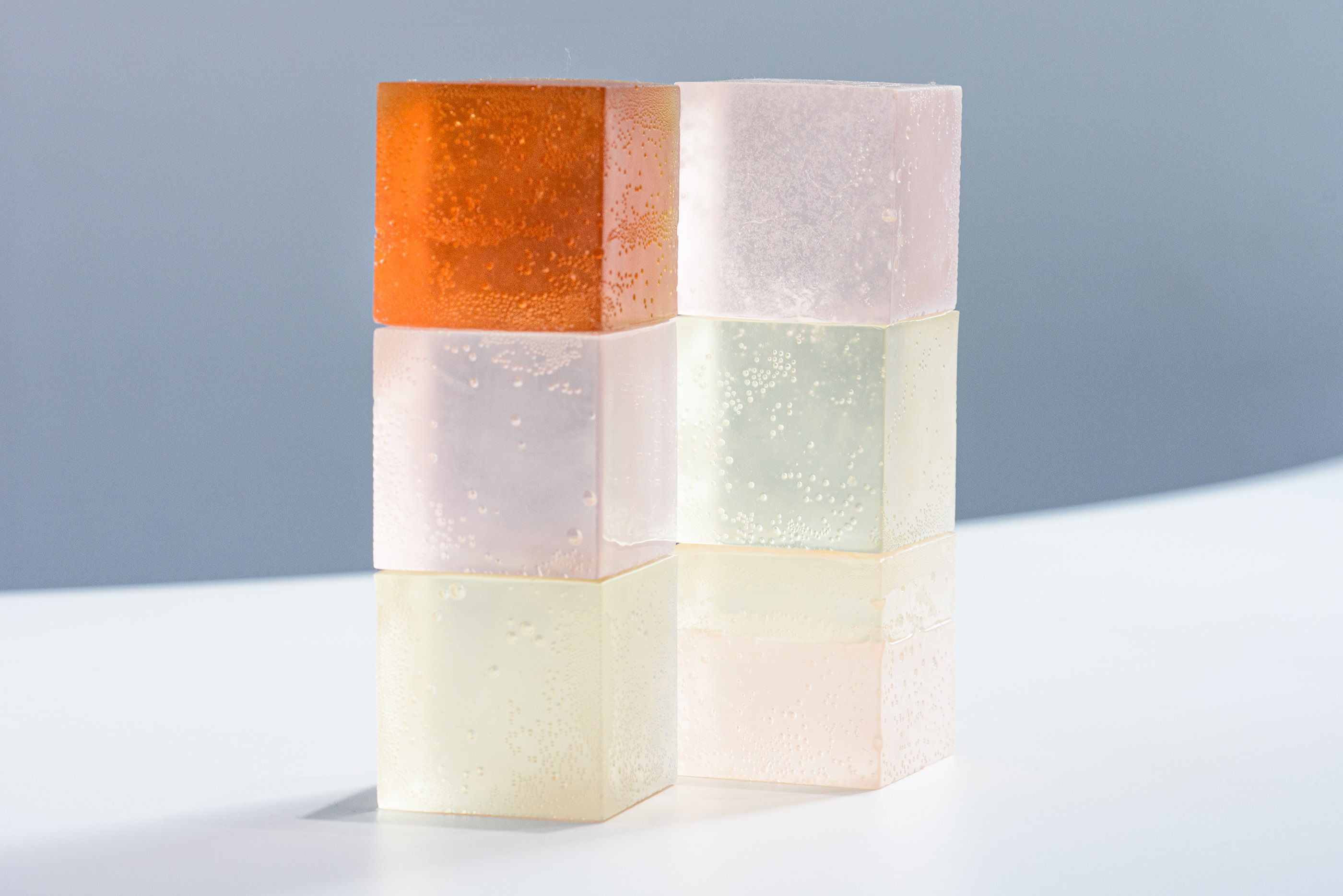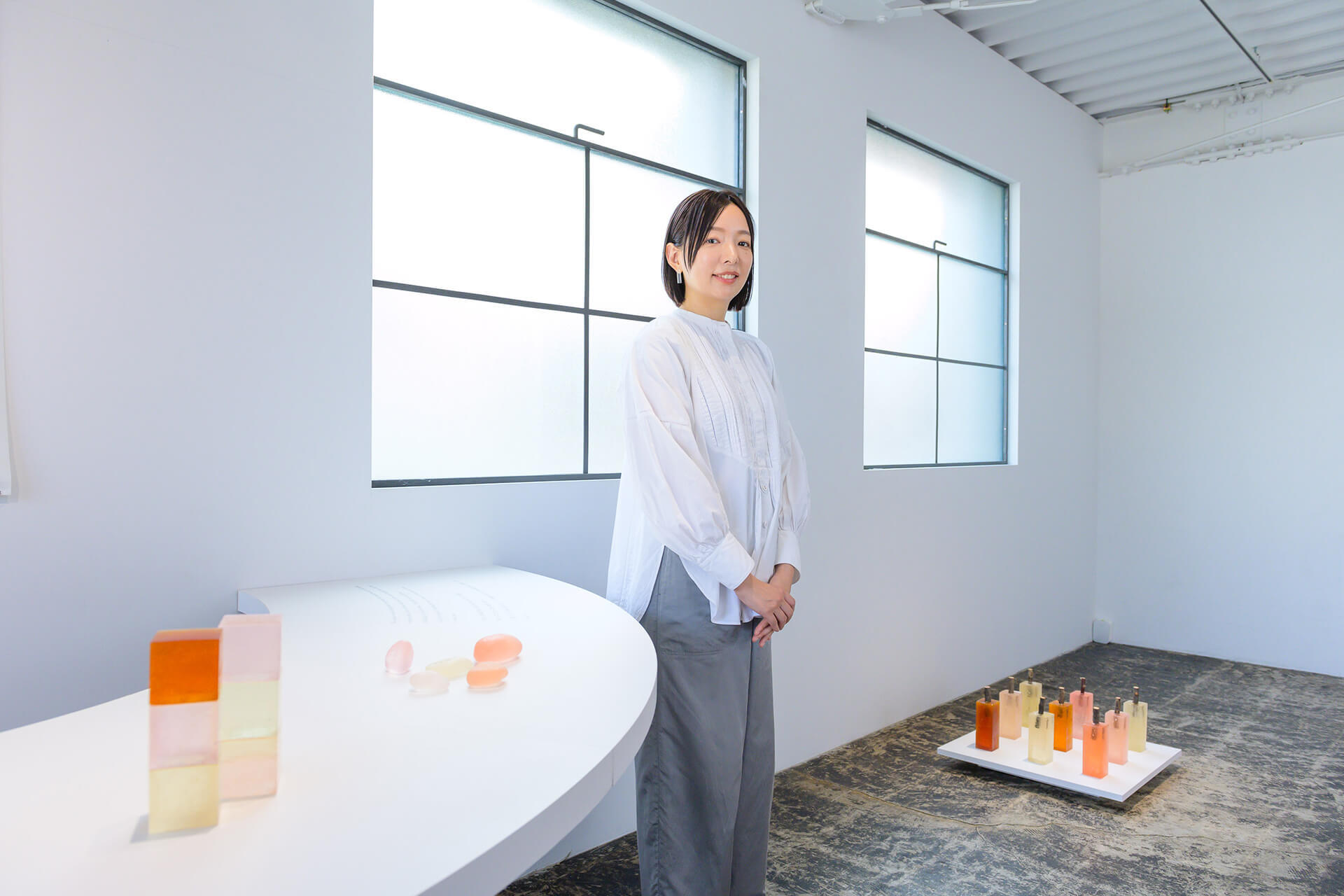The AWRD Creator Interview Series, where we ask leading creators about the stories behind their works and the sources of their inspiration, continues with Volume 2. This time, we spoke with Shizuka Tatsuno, a creative director and designer.
Shizuka Tatsuno, who is involved in a wide range of activities both in Japan and abroad—ranging from product design, planning, and direction to branding and graphics—held an exhibition titled "a moment in time -book-" at the BOOK AND SONS bookstore at Tokyo Gakugei University from October 3 to 13, 2024. At the exhibition, she shared insights into the creative process behind the art projects she has been working on since 2021, as well as her unique perspective on creative direction.
Her Work "a moment in time -ume-" captures the color of ume, or plums, within candy
-This exhibition features the work "a moment in time -ume-" where the color extracted from plum trees using the technique of plant dyeing is captured within candy, as well as a book that showcases photographs of these works. How did you begin making this piece?
Shizuka Tatsuno (abbreviated hereafter): In 2021, I was invited to hold a solo exhibition as part of the opening of the alternative space "Nadoya Yoyogi-Uehara" in Yoyogi-Uehara, which served as the catalyst for starting this project.
Originally, the exhibition request was for a display of the products I had worked on in the past. However, when I visited "Nadoya Ebisu," another location that had recently opened in Ebisu, I was struck by the unique space—a renovated old house that was scheduled for demolition a few months later—and by a large, ancient plum tree planted on the property.
The plum tree was deeply cherished and cared for by the staff of Nadoya, as well as by the people who gathered there, and the way they treated it left a lasting impression on me. I found myself vaguely thinking that I wanted to create something using this plum tree.

At that time, we were in the midst of the COVID-19 pandemic, and several of my projects had come to a halt, giving me the chance to reflect on myself and my approach to creating. At the same time, there was a growing awareness of environmental issues and the need for a sustainable future, with many media outlets—magazines, websites, TV, and so on—beginning to feature these topics more frequently.
Personally, I’ve always been deeply concerned about these issues, and I had already been conscious of them when working with clients. However, the pandemic prompted me to think even more deeply, and I believe this was a key factor in the creation of this artwork.
Beyond environmental issues, as society began to undergo significant changes, I found myself reflecting on the value of things. Through this process, I started to reconsider the values that had previously been seen as "normal" and began contemplating what values I truly felt were important and meaningful.
- How did these reflections lead to the idea for this work?
In the world of Japanese tea ceremony, which I have been practicing for over 20 years, there is a philosophy that emphasizes the importance of "the present moment." People tend to seek things that remain unchanged, but through my experiences in tea ceremony, I began to question whether anything truly remains forever. I started to feel that the beauty of things that change, and the value that can only be experienced in a given moment, are what I would like to create.
At the same time, I’ve long had a desire to work on projects that I can't normally pursue in my regular client work. So, I decided to embark on an experimental project to convey the allure and transience of life. I wanted to create a piece using the plum tree from "Nodaya Ebisu," which, in a few months, would no longer exist.

- Why did you choose candy as your material?
I was thinking of using the technique of plant-based dyeing to extract color from the plum tree at "Nodaya Ebisu," but I was looking for a material that could convey the story of the work, rather than fabric or washi paper. I ultimately chose candy because it seemed to resonate with the colors of the plants, which vary depending on the season, age of the tree, and where it grows.
Candy is a material that changes its form due to factors like humidity and temperature, and it can turn white due to crystallization. By capturing the fleeting color of the plum, which can only be extracted at a certain moment, in candy—a material that cannot hold its shape indefinitely—I felt it would help express the story of the piece.

Crafting that conveys the creators' charm
- What do you focus on in your work?
Since I became independent, I’ve made it a point to design while being mindful of the context of craftsmanship and materials. However, I also believe that a product should not be overly explanatory, especially since it’s something people use every day. So, I aim to create a balance where the qualities I find beautiful or intriguing subtly appear in a way that feels natural, as if they are always there for those who choose to engage with them.

Recently, I’ve come to realize once again that I find it difficult to create something unless I’m personally moved by it. So, I’ve started looking for the hidden beauty within the process of creation. By approaching design with the intention of saying, "This is what I find wonderful about you," I hope to help creators rediscover their own strengths and unique qualities, and give them opportunities to be appreciated by others. When something born from this process resonates with many people, it gives me a true sense of accomplishment.

-Are there any practices you follow to understand these contexts better?
I’ve loved researching since university, and I have a strong desire to design with a deep understanding of the materials and techniques involved. So, when collaborating with clients, I always ask for as much information as possible.
Of course, I also do my own research, but there is often a wealth of knowledge among the creators that’s beyond what I can consider alone. I want to learn as much as I can before creating the best possible outcome.
Additionally, when working with manufacturers, I try to visit their factories as much as possible to understand where their strengths lie. Even if it’s not directly related to the project, I sometimes get invited to visit factories in rural areas. There are still many factories I haven’t visited yet, but when I do visit a fabric factory, it’s not uncommon to hear something like, "Oh, Issey Miyake came here before." I find it fascinating to come across traces of such pioneers at factories in the countryside.
"Moment," a new work exploring the possibilities of expression through sheet metal
- You exhibited at DESIGNTIDE TOKYO 2024, which was held for the first time in 12 years. Could you tell us about the works you showcased??
I presented a new work created in collaboration with Japan Benex Corporation. a company based in Nagasaki. Nihon Benex specializes in precision sheet metal processing for public and industrial products. When I first visited their factory after receiving the commission, I was impressed by their flexible approach to new types of manufacturing. At the same time, I was able to discover delicate techniques that resembled traditional craftsmanship.
To make the most of Nihon Benex’s strengths, the idea that came to mind was to create an object with a simple, orderly pattern, featuring a geometric form. If I had designed a functional tool, elements like durability and usability would have come into play, which I felt would limit the potential of sheet metal. So, I consciously decided to design an object instead.

In sheet metal techniques, when processing geometric shapes, even the slightest distortion or misalignment becomes very noticeable. I thought that by creating a geometric-shaped object—something that could only be achieved with highly skilled craftsmanship—I would be able to produce a product that truly showcases their expertise and capabilities.

Throughout the production process, I requested multiple remakes to correct even the slightest distortion, and we were able to refine the piece through trial and error. Achieving such a thin frame would have been a challenge to recreate with wood, and the ability to create a structure as thin as 1mm—resembling the delicate fold of paper—while keeping it in a light, yet dignified form, is an expression unique to sheet metal techniques.
Continuing with Sincerity and Full Commitment
-Ms. Tatsuno, you have served as a judge for various awards such as the Good Design Award and the Takaoka Craft Contest. Have you had any personal experiences with awards in your own career?
I have never applied for awards through my own initiative, but winning the ELLE DECOR "Young Japanese Design Talents" award in 2016 was a huge turning point for me as a designer. When I received the notification of the award, I burst into tears in front of my computer—I was overwhelmed with joy. At the time, I was just focused on quietly working on what I wanted to do, so it meant so much to me to know that my work had been noticed.
Additionally, when I had just started working independently, I collaborated with a traditional cord maker, and through their recommendation, I participated in a project organized by the The Association for the Promotion of Traditional Craft Industries, which led to another award. The following year, I received another award for a different project, which helped me gain recognition in the field of traditional crafts and opened doors for future opportunities.
As a judge for the Good Design Award, I've seen many people at the award ceremonies crying with joy, and many businesses and teams gain new momentum after receiving an award. Watching them gain confidence through their achievements really highlights the significance of awards to me.
- Finally, could you share a message for young creators?
For young creators in particular, there may be times when you feel isolated, especially when your work is not recognized by anyone. However, I believe that, just like me, if you keep going, eventually someone will notice your efforts.
I never imagined I would become a judge for the Good Design Award, and until I received the ELLE DECOR award, I didn’t have the sense that anyone was truly paying attention to my work. Even so, I believe that if you keep creating, someone will eventually take notice. That’s why I think the most important thing is to stay sincere and dedicated, putting your heart and soul into what you find truly wonderful.

Profile: Shizuka Tatsuno
Creative Director & Designer, Shizuka Tatsuno Studio Inc.
She graduated from Kingston University in London with a Product & Furniture Design degree and established her design studio in 2011. She specializes in exploring the hidden potential in things and elevating them to visible forms by creating practical tools and emotive objects. Beyond design, she is deeply involved in design aesthetics, conceptualization and development, and product planning, which form a brand's core. She strives to create simple expressions that focus on the project's key concepts. Her work extends beyond traditional frameworks, encompassing various fields around product design, including art direction, exhibition space direction, food design, and art production.
https://www.shizukatatsuno.com/en/
Written by: Toshihiro Horiai
Edited by: AWRD
Top & Venue Photography: Toshiya Abe




